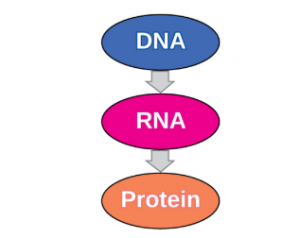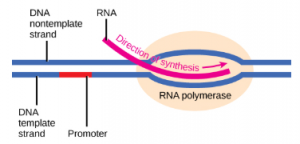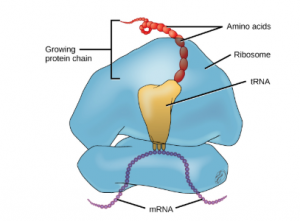Protein Synthesis
Learning Objectives
Know what messenger RNA is.
Understand the relationship between genes and proteins.
Know how genes spell out a series of amino acids.
Know the difference between transcription and translation.
Hi everyone, today we’ll be talking about protein synthesis, which refers to how proteins are made in cells.
To understand protein synthesis we first have to understand the central dogma, which describes the processes of DNA replication, transcription, and translation.

DNA replication is the process of using DNA to produce more copies of itself, and uses many essential enzymes such as DNA Polymerase. Transcription is the process of making RNA from DNA. It uses enzymes such as RNA Polymerase. Translation is the process of using a mRNA template to make a polypeptide, which is a chain of amino acids. Proteins are made up of one or more polypeptides. Today we’ll be focusing on transcription and translation.

You may have already learned that DNA is double stranded, and is made up of two identical but complementary strands. You may also know that DNA is made up of nucleotides, that we label as A, T, G, or C. A single strand of DNA is made up of a sequence of these nucleotides.
DNA sequences make up genes, which can specify the production proteins. We’ll talk about this more later.
During transcription, one of the two DNA strands acts as a template for making RNA. Here, a complementary RNA strand is produced that matches the non-template strand of DNA, with an exception. In RNA, the U nucleotides take the place of the Ts. The product of transcription is a single strand of RNA, which is usually then processed in eukaryotes to become a mature mRNA, which stands for messenger RNA. The mature mRNA can then be used as a template to produce polypeptides, which is described as translation.

During translation, a sequence of mRNA is used to produce a polypeptide with a specific amino acid sequence. You know that mRNA is made up of a nucleotide sequence of A, U, G, and C’s. This sequence is read in groups three’s, called codons. Different codons specify different amino acids, with some also signaling the start or stop of termination. Those that do so are called start or stop codons.
To start translation, a ribosome will latch onto a strand of mRNA and find the start codon. As the ribosome moves along the mRNA strand, a chain of amino acids is built according to the mRNA sequence. tRNA molecules bring amino acids that are specific to their codons. When the ribosome reaches a stop codon, it releases the polypeptide. The polypeptide can then be combined with other polypeptides or act as its own in a variety of functions.

